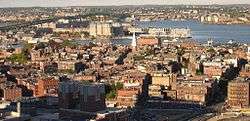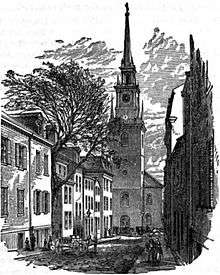Old North Church
|
Old North Church | |
 Image of the North End, Boston neighborhood. The Old North Church is at center, a Big Dig vent building is near the bottom, and the green Tobin Bridge over the Mystic River is at the top. | |
| Location | Boston |
|---|---|
| Coordinates | 42°21′58.78″N 71°3′16.04″W / 42.3663278°N 71.0544556°WCoordinates: 42°21′58.78″N 71°3′16.04″W / 42.3663278°N 71.0544556°W |
| Built | 1723 |
| Architect | Price, William |
| Architectural style | Georgian |
| NRHP Reference # | [1] |
| Significant dates | |
| Added to NRHP | October 15, 1966 |
| Designated NHL | January 20, 1961 |

Old North Church (officially, Christ Church in the City of Boston), at 193 Salem Street, in the North End, Boston, is the location from which the famous "One if by land, and two if by sea" signal is said to have been sent. This phrase is related to Paul Revere's midnight ride, of April 18, 1775, which preceded the Battles of Lexington and Concord during the American Revolution.
The church is a mission of the Episcopal Diocese of Massachusetts. It is the oldest standing church building in Boston and is a National Historic Landmark. Inside the church is a bust of George Washington, which Gilbert du Motier, Marquis de Lafayette, reportedly remarked was the best likeness of the first president he had ever seen.
History
The Old North Church was built in December, 1723, and was inspired by the works of Christopher Wren, the British architect who was responsible for rebuilding London after the Great Fire. Timothy Cutler was the founding rector after serving as third rector of Yale College from 1719 to 1722.
In April 1775, Paul Revere told three Boston patriots to hang two lanterns in the steeple. These men were the church sexton Robert Newman and Captain John Pulling—the two of whom historian David Hackett Fischer suggests each carried one lantern up to the steeple—as well as Thomas Bernard, who stood watch for British troops outside the church. The lanterns were displayed to send a warning to Charlestown patriots across the Charles River about the movements of the British Army. Revere and William Dawes would later deliver the same message to Lexington themselves, but this lantern method was a fast way to inform the back-up riders in Charlestown about the movements of the British; these back-up riders planned to deliver the warning message to Lexington and Concord in case Revere and Dawes were arrested on the way.
The lanterns were hung for just under a minute to avoid catching the eyes of the British troops occupying Boston, but this was long enough for the message to be received in Charlestown. The militia waiting across the river had been told to look for the signal lanterns, and were prepared to act as soon as they saw them.
The meaning of two lanterns has been memorized by countless American schoolchildren. "One if by land, and two if by sea" is from Henry Wadsworth Longfellow's poem "Paul Revere's Ride". One lantern was to notify Charlestown that the British Army would march over Boston Neck and the Great Bridge, and two were to notify them that the troops were taking boats across the Charles River to land near Phips farm (the British Army would take the "sea" route; thus, two lanterns were hung). After receiving the signal, the Charlestown Patriots sent out a rider to Lexington, but this rider did not reach his destination and his identity has disappeared from history. He was the one who might have been captured by a British patrol.
But the warning was delivered miles away to dozens of towns, first by Revere and Dawes on horses, and then by other men on horses and men who rang church bells and town bells, beat drums, and shot off warning guns. (The current status of the lanterns is not entirely clear; one is said to be in the hands of a private collector, another broken during a tour, and yet another is on display at the Concord Museum.)
U.S. bicentennial celebration

President Gerald Ford visited Old North Church on April 18, 1975. In his nationally televised speech, the President said, in part:
Let us pray here in the Old North Church tonight that those who follow 100 years or 200 years from now may look back at us and say: We were a society which combined reason with liberty and hope with freedom. May it be said above all: We kept the faith, freedom flourished, liberty lived. These are the abiding principles of our past and the greatest promise of our future.
Following President Ford's remarks, two lanterns were lit by Robert Newman Ruggles and Robert Newman Sheet, descendants of Robert Newman, who, as sexton of the Old North Church in 1775, lit the two lanterns which signaled the movement of British troops. The President then lit a third lantern, which hangs in a window of the church today.
On July 11, 1976, Queen Elizabeth II visited Boston as part of celebrations honoring the United States Bicentennial, and made reference to the aforementioned celebration events in April 1975 that followed President Ford's speech. She said: "At the Old North Church last year, your President lit a third lantern dedicated to America's third century of freedom and to renewed faith in the American ideals. May its light never be dimmed."
The Queen and Prince Philip attended a Sunday morning service at the Old North Church, sitting in a pew at the right front. The Rev. Robert W. Golledge led the service and later presented the Queen with a replica of a silver chalice made by Paul Revere. The Queen was shown the iconic statue of Paul Revere by Cyrus E. Dallin near the church before departing in a motorcade to attend a function at the Old State House.
The bells
Eight change ringing bells (tenor: 13 long cwt 3 qr 5 lb (1,545 lb or 701 kg) in F) at Old North Church were cast by Abel Rudhall (Rudhall of Gloucester) in Gloucester, England in 1744 and hung in 1745.[2] One bell has the inscription: "We are the first ring of bells cast for the British Empire in North America, A.R. 1744." The bells were restored in 1894 and in 1975. They are maintained and rung regularly by the Massachusetts Institute of Technology Guild of Bellringers.
Steeple damage

The original steeple of the Old North Church was destroyed by the 1804 Snow hurricane. A replacement steeple, designed by Charles Bulfinch, was toppled by Hurricane Carol on August 25, 1954. The current steeple uses design elements from the original and the Bulfinch version. The church is now 174 feet (53 m) tall.[3] At its tip is the original weather vane.
The other "Old North"
Before the construction of the "Old North Church" (Christ Church, Boston), there was another church in Boston called the "Old North" (Meetinghouse). This Congregationalist meeting house was founded in North Square, across the street from what is now called "Paul Revere's house". This church was once pastored by Cotton Mather, the minister now known largely for his involvement in the Salem witch trials.
Crypt
In 2009, an archeologist began examining the estimated 1,100 bodies buried in 37 tombs in the basement.[4] The crypt was in use between 1732 and 1860, and each tomb is sealed with a wooden or slate door, with many doors covered over by plaster as ordered by the city of Boston in the 1850s.
Founding Rector Timothy Cutler and his wife were buried under the altar together. Other notable figures buried under the church include British Marine Major John Pitcairn, who died at the Battle of Bunker Hill and was entombed along with many other soldiers killed in this battle. So is Captain Samuel Nicholson of the USS Constitution. A behind the scenes tour run by the church takes tourists down into the crypt, as well as up to the bell-ringing chamber.
Today
Old North Church is today one of four church sites among the 16 stops on the Freedom Trail.
See also
- Forest Lawn Memorial Park (Hollywood Hills), where there is a replica of the church
- List of National Historic Landmarks in Boston
- National Register of Historic Places listings in northern Boston
References
- ↑ National Park Service (2007-01-23). "National Register Information System". National Register of Historic Places. National Park Service.
- ↑ Dove's Guide for Church Bell Ringers
- ↑ Skyscraperpage.com
- ↑ Secrets: Church of the Dead
Further reading
- Asa Eaton. Historical account of Christ church, Boston: A discourse in said church, on Sunday, December 28, 1823. Boston: Printed by J.W. Ingraham, 1824. Google books
- Henry Burroughs. A historical account of Christ Church, Boston: an address, delivered on the one hundred and fiftieth anniversary of the opening of the church, December 29, 1873. Boston: A. Williams & Co., 1874. Google books
- Christ Church, Salem Street, Boston, 1723. Boston: 1912. Google books
- Percival Merritt. The parochial library of the eighteenth century in Christ Church, Boston. Boston: Merrymount Press, 1917
External links
| Wikimedia Commons has media related to Old North Church. |
- Old North Church
- Mayo family history
- Boston National Historical Park Official Website
- Listing and photographs at the Historic American Buildings Survey
- Old North Church (Christ Church) at Find a Grave
- C-SPAN American History TV Tour of Old North Church - Part 1
- C-SPAN American History TV Tour of Old North Church - Part 2
| Preceded by Old State House, Boston |
Tallest Building in Boston 1745–1810 53 m |
Succeeded by Park Street Church |
| Preceded by Paul Revere House |
Locations along Boston's Freedom Trail Old North Church |
Succeeded by Copp's Hill |
